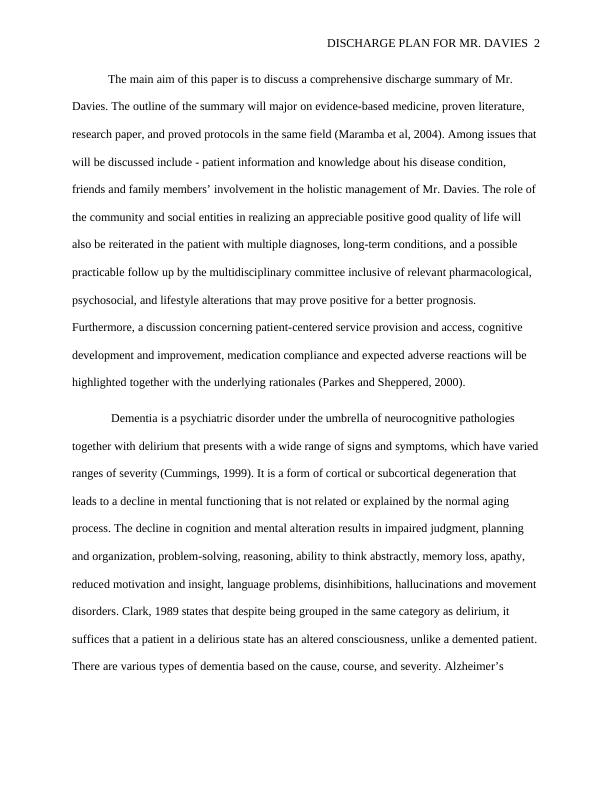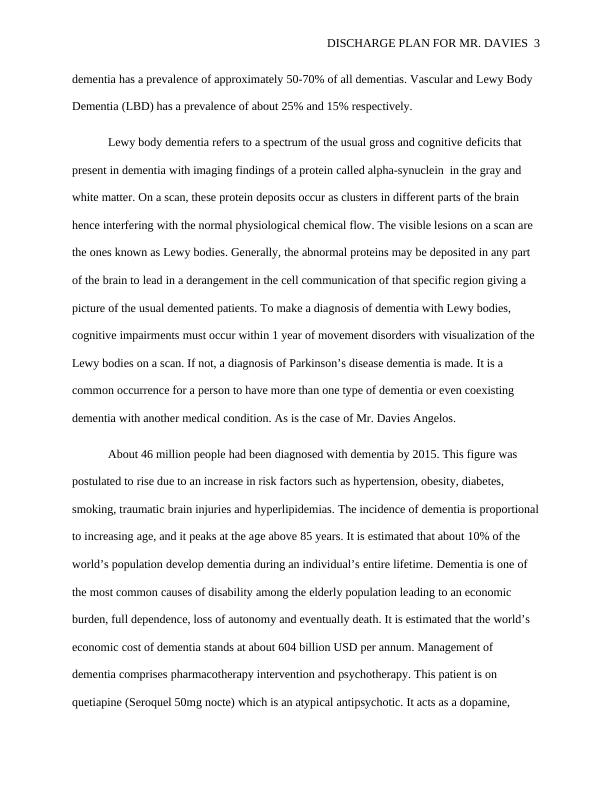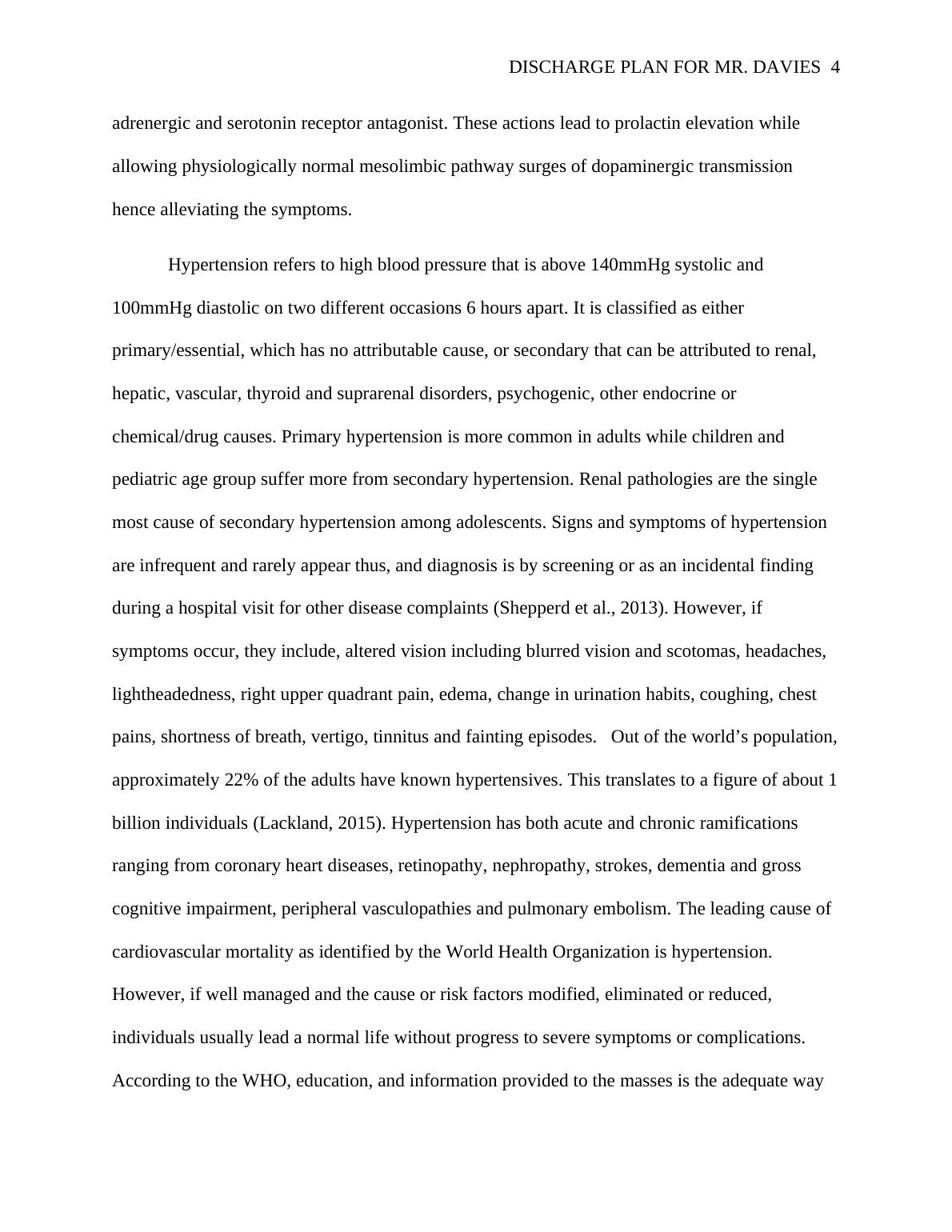(PDF) Comprehensive Discharge Planning
19 Pages5203 Words46 Views
Added on 2021-04-24
(PDF) Comprehensive Discharge Planning
Added on 2021-04-24
ShareRelated Documents
DISCHARGE PLAN FOR MR. DAVIES 1
DISCHARGE PLAN FOR MR. DAVIES
[Name]
Course
Professor’s Name
Institution
Location of Institution
Date
Introduction
DISCHARGE PLAN FOR MR. DAVIES
[Name]
Course
Professor’s Name
Institution
Location of Institution
Date
Introduction

DISCHARGE PLAN FOR MR. DAVIES 2
The main aim of this paper is to discuss a comprehensive discharge summary of Mr.
Davies. The outline of the summary will major on evidence-based medicine, proven literature,
research paper, and proved protocols in the same field (Maramba et al, 2004). Among issues that
will be discussed include - patient information and knowledge about his disease condition,
friends and family members’ involvement in the holistic management of Mr. Davies. The role of
the community and social entities in realizing an appreciable positive good quality of life will
also be reiterated in the patient with multiple diagnoses, long-term conditions, and a possible
practicable follow up by the multidisciplinary committee inclusive of relevant pharmacological,
psychosocial, and lifestyle alterations that may prove positive for a better prognosis.
Furthermore, a discussion concerning patient-centered service provision and access, cognitive
development and improvement, medication compliance and expected adverse reactions will be
highlighted together with the underlying rationales (Parkes and Sheppered, 2000).
Dementia is a psychiatric disorder under the umbrella of neurocognitive pathologies
together with delirium that presents with a wide range of signs and symptoms, which have varied
ranges of severity (Cummings, 1999). It is a form of cortical or subcortical degeneration that
leads to a decline in mental functioning that is not related or explained by the normal aging
process. The decline in cognition and mental alteration results in impaired judgment, planning
and organization, problem-solving, reasoning, ability to think abstractly, memory loss, apathy,
reduced motivation and insight, language problems, disinhibitions, hallucinations and movement
disorders. Clark, 1989 states that despite being grouped in the same category as delirium, it
suffices that a patient in a delirious state has an altered consciousness, unlike a demented patient.
There are various types of dementia based on the cause, course, and severity. Alzheimer’s
The main aim of this paper is to discuss a comprehensive discharge summary of Mr.
Davies. The outline of the summary will major on evidence-based medicine, proven literature,
research paper, and proved protocols in the same field (Maramba et al, 2004). Among issues that
will be discussed include - patient information and knowledge about his disease condition,
friends and family members’ involvement in the holistic management of Mr. Davies. The role of
the community and social entities in realizing an appreciable positive good quality of life will
also be reiterated in the patient with multiple diagnoses, long-term conditions, and a possible
practicable follow up by the multidisciplinary committee inclusive of relevant pharmacological,
psychosocial, and lifestyle alterations that may prove positive for a better prognosis.
Furthermore, a discussion concerning patient-centered service provision and access, cognitive
development and improvement, medication compliance and expected adverse reactions will be
highlighted together with the underlying rationales (Parkes and Sheppered, 2000).
Dementia is a psychiatric disorder under the umbrella of neurocognitive pathologies
together with delirium that presents with a wide range of signs and symptoms, which have varied
ranges of severity (Cummings, 1999). It is a form of cortical or subcortical degeneration that
leads to a decline in mental functioning that is not related or explained by the normal aging
process. The decline in cognition and mental alteration results in impaired judgment, planning
and organization, problem-solving, reasoning, ability to think abstractly, memory loss, apathy,
reduced motivation and insight, language problems, disinhibitions, hallucinations and movement
disorders. Clark, 1989 states that despite being grouped in the same category as delirium, it
suffices that a patient in a delirious state has an altered consciousness, unlike a demented patient.
There are various types of dementia based on the cause, course, and severity. Alzheimer’s

DISCHARGE PLAN FOR MR. DAVIES 3
dementia has a prevalence of approximately 50-70% of all dementias. Vascular and Lewy Body
Dementia (LBD) has a prevalence of about 25% and 15% respectively.
Lewy body dementia refers to a spectrum of the usual gross and cognitive deficits that
present in dementia with imaging findings of a protein called alpha-synuclein in the gray and
white matter. On a scan, these protein deposits occur as clusters in different parts of the brain
hence interfering with the normal physiological chemical flow. The visible lesions on a scan are
the ones known as Lewy bodies. Generally, the abnormal proteins may be deposited in any part
of the brain to lead in a derangement in the cell communication of that specific region giving a
picture of the usual demented patients. To make a diagnosis of dementia with Lewy bodies,
cognitive impairments must occur within 1 year of movement disorders with visualization of the
Lewy bodies on a scan. If not, a diagnosis of Parkinson’s disease dementia is made. It is a
common occurrence for a person to have more than one type of dementia or even coexisting
dementia with another medical condition. As is the case of Mr. Davies Angelos.
About 46 million people had been diagnosed with dementia by 2015. This figure was
postulated to rise due to an increase in risk factors such as hypertension, obesity, diabetes,
smoking, traumatic brain injuries and hyperlipidemias. The incidence of dementia is proportional
to increasing age, and it peaks at the age above 85 years. It is estimated that about 10% of the
world’s population develop dementia during an individual’s entire lifetime. Dementia is one of
the most common causes of disability among the elderly population leading to an economic
burden, full dependence, loss of autonomy and eventually death. It is estimated that the world’s
economic cost of dementia stands at about 604 billion USD per annum. Management of
dementia comprises pharmacotherapy intervention and psychotherapy. This patient is on
quetiapine (Seroquel 50mg nocte) which is an atypical antipsychotic. It acts as a dopamine,
dementia has a prevalence of approximately 50-70% of all dementias. Vascular and Lewy Body
Dementia (LBD) has a prevalence of about 25% and 15% respectively.
Lewy body dementia refers to a spectrum of the usual gross and cognitive deficits that
present in dementia with imaging findings of a protein called alpha-synuclein in the gray and
white matter. On a scan, these protein deposits occur as clusters in different parts of the brain
hence interfering with the normal physiological chemical flow. The visible lesions on a scan are
the ones known as Lewy bodies. Generally, the abnormal proteins may be deposited in any part
of the brain to lead in a derangement in the cell communication of that specific region giving a
picture of the usual demented patients. To make a diagnosis of dementia with Lewy bodies,
cognitive impairments must occur within 1 year of movement disorders with visualization of the
Lewy bodies on a scan. If not, a diagnosis of Parkinson’s disease dementia is made. It is a
common occurrence for a person to have more than one type of dementia or even coexisting
dementia with another medical condition. As is the case of Mr. Davies Angelos.
About 46 million people had been diagnosed with dementia by 2015. This figure was
postulated to rise due to an increase in risk factors such as hypertension, obesity, diabetes,
smoking, traumatic brain injuries and hyperlipidemias. The incidence of dementia is proportional
to increasing age, and it peaks at the age above 85 years. It is estimated that about 10% of the
world’s population develop dementia during an individual’s entire lifetime. Dementia is one of
the most common causes of disability among the elderly population leading to an economic
burden, full dependence, loss of autonomy and eventually death. It is estimated that the world’s
economic cost of dementia stands at about 604 billion USD per annum. Management of
dementia comprises pharmacotherapy intervention and psychotherapy. This patient is on
quetiapine (Seroquel 50mg nocte) which is an atypical antipsychotic. It acts as a dopamine,

DISCHARGE PLAN FOR MR. DAVIES 4
adrenergic and serotonin receptor antagonist. These actions lead to prolactin elevation while
allowing physiologically normal mesolimbic pathway surges of dopaminergic transmission
hence alleviating the symptoms.
Hypertension refers to high blood pressure that is above 140mmHg systolic and
100mmHg diastolic on two different occasions 6 hours apart. It is classified as either
primary/essential, which has no attributable cause, or secondary that can be attributed to renal,
hepatic, vascular, thyroid and suprarenal disorders, psychogenic, other endocrine or
chemical/drug causes. Primary hypertension is more common in adults while children and
pediatric age group suffer more from secondary hypertension. Renal pathologies are the single
most cause of secondary hypertension among adolescents. Signs and symptoms of hypertension
are infrequent and rarely appear thus, and diagnosis is by screening or as an incidental finding
during a hospital visit for other disease complaints (Shepperd et al., 2013). However, if
symptoms occur, they include, altered vision including blurred vision and scotomas, headaches,
lightheadedness, right upper quadrant pain, edema, change in urination habits, coughing, chest
pains, shortness of breath, vertigo, tinnitus and fainting episodes. Out of the world’s population,
approximately 22% of the adults have known hypertensives. This translates to a figure of about 1
billion individuals (Lackland, 2015). Hypertension has both acute and chronic ramifications
ranging from coronary heart diseases, retinopathy, nephropathy, strokes, dementia and gross
cognitive impairment, peripheral vasculopathies and pulmonary embolism. The leading cause of
cardiovascular mortality as identified by the World Health Organization is hypertension.
However, if well managed and the cause or risk factors modified, eliminated or reduced,
individuals usually lead a normal life without progress to severe symptoms or complications.
According to the WHO, education, and information provided to the masses is the adequate way
adrenergic and serotonin receptor antagonist. These actions lead to prolactin elevation while
allowing physiologically normal mesolimbic pathway surges of dopaminergic transmission
hence alleviating the symptoms.
Hypertension refers to high blood pressure that is above 140mmHg systolic and
100mmHg diastolic on two different occasions 6 hours apart. It is classified as either
primary/essential, which has no attributable cause, or secondary that can be attributed to renal,
hepatic, vascular, thyroid and suprarenal disorders, psychogenic, other endocrine or
chemical/drug causes. Primary hypertension is more common in adults while children and
pediatric age group suffer more from secondary hypertension. Renal pathologies are the single
most cause of secondary hypertension among adolescents. Signs and symptoms of hypertension
are infrequent and rarely appear thus, and diagnosis is by screening or as an incidental finding
during a hospital visit for other disease complaints (Shepperd et al., 2013). However, if
symptoms occur, they include, altered vision including blurred vision and scotomas, headaches,
lightheadedness, right upper quadrant pain, edema, change in urination habits, coughing, chest
pains, shortness of breath, vertigo, tinnitus and fainting episodes. Out of the world’s population,
approximately 22% of the adults have known hypertensives. This translates to a figure of about 1
billion individuals (Lackland, 2015). Hypertension has both acute and chronic ramifications
ranging from coronary heart diseases, retinopathy, nephropathy, strokes, dementia and gross
cognitive impairment, peripheral vasculopathies and pulmonary embolism. The leading cause of
cardiovascular mortality as identified by the World Health Organization is hypertension.
However, if well managed and the cause or risk factors modified, eliminated or reduced,
individuals usually lead a normal life without progress to severe symptoms or complications.
According to the WHO, education, and information provided to the masses is the adequate way

End of preview
Want to access all the pages? Upload your documents or become a member.
Related Documents
Discharge Planning Case Studieslg...
|19
|4617
|45
These tangles and plaques in the brainlg...
|4
|792
|23
Discharge planning: Communication, education and patient participationlg...
|19
|4954
|141
Dementia: Risk Factors, Pathophysiology, and Treatmentlg...
|4
|1432
|404
Nursing Care Assignment | Dementia Care Assignmentlg...
|10
|2199
|115
Alzheimer’s Disease: Symptoms, Stages, Diagnosis and Treatmentlg...
|13
|734
|351
